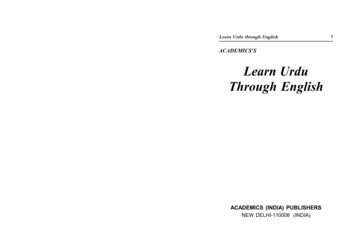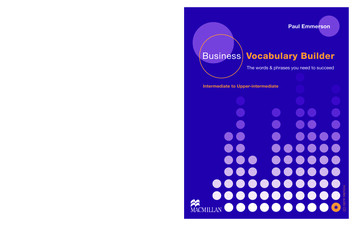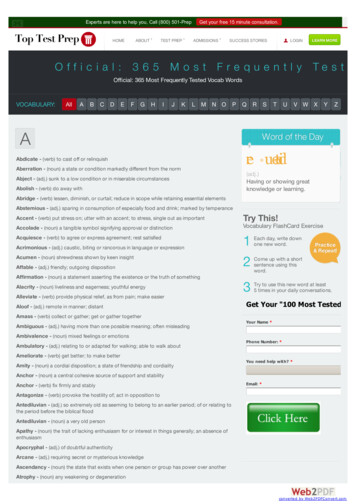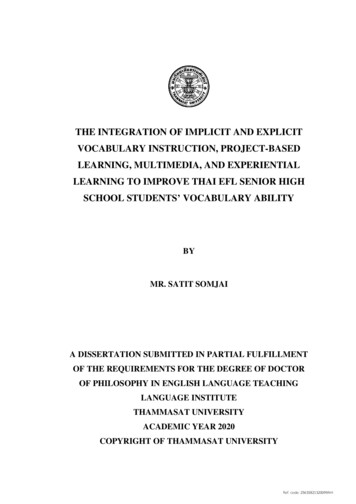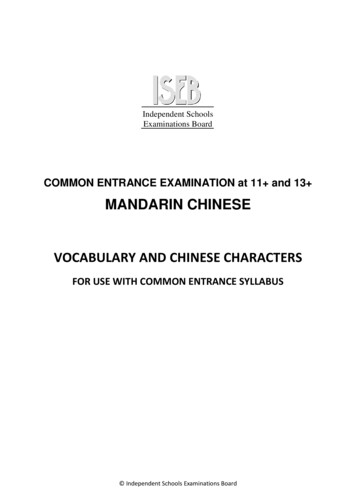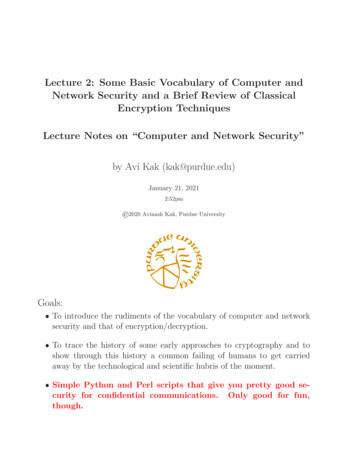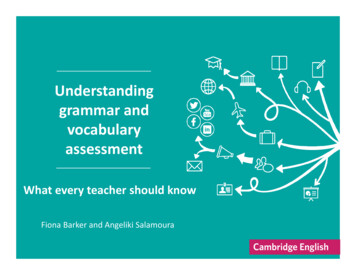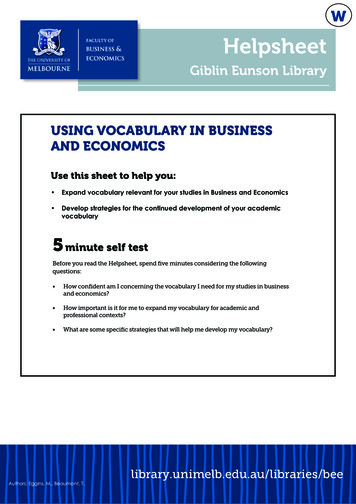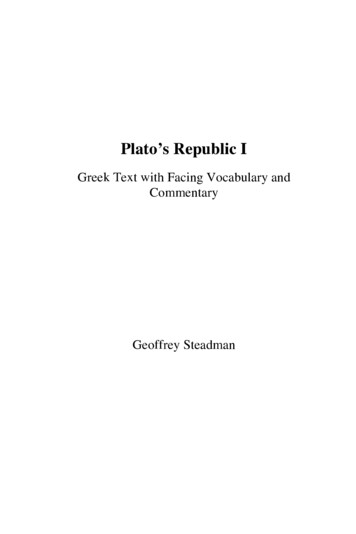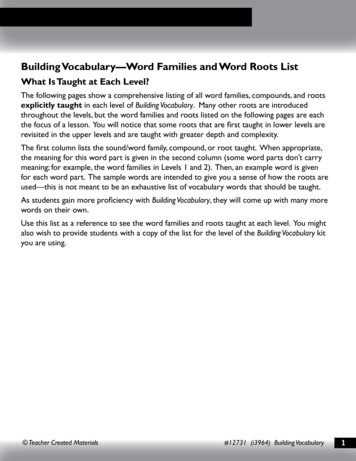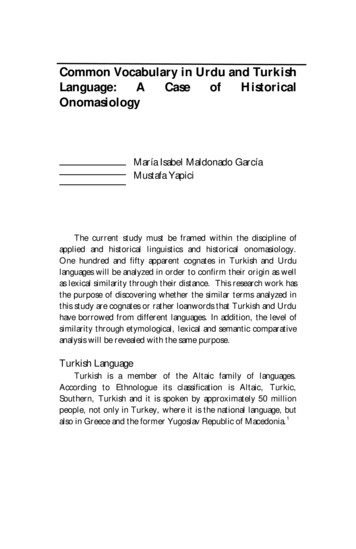
Transcription
Common Vocabulary in Urdu and TurkishLanguage: A Case of HistoricalOnomasiologyMaría Isabel Maldonado GarcíaMustafa YapiciThe current study must be framed within the discipline ofapplied and historical linguistics and historical onomasiology.One hundred and fifty apparent cognates in Turkish and Urdulanguages will be analyzed in order to confirm their origin as wellas lexical similarity through their distance. This research work hasthe purpose of discovering whether the similar terms analyzed inthis study are cognates or rather loanwords that Turkish and Urduhave borrowed from different languages. In addition, the level ofsimilarity through etymological, lexical and semantic comparativeanalysis will be revealed with the same purpose.Turkish LanguageTurkish is a member of the Altaic family of languages.According to Ethnologue its classification is Altaic, Turkic,Southern, Turkish and it is spoken by approximately 50 millionpeople, not only in Turkey, where it is the national language, butalso in Greece and the former Yugoslav Republic of Macedonia.1
194Pakistan Vision Vol. 15 No.1Table 1Altaic Languages- Turkish2During the Ottoman Empire which lasted more than 600years, the Turkish language flourished as the language of theadministration, receiving loanwords from Arabic and Persian.The language was then named Ottoman Turkish, actually a formalversion of the everyday spoken Turkish of the time. Some ofAtaturk’s reforms included a new Turkish alphabet. However,“the aim of the Turkish language reform was to eliminate the Arabic andPersiangrammatical features and the many thousands of Arabic andPersian borrowings that had long been a part of the language.” (1999,2)3. The borrowing of Persian words was without any doubt of aconsiderable importance. Arabic on the other hand had a largerinfiltration, due to two main factors; a religious factor since it isthe language of the Quran and the other because Persian languagehad itself borrowed innumerable terms from Arabic and when anArabic term was borrowed it brought with it the complete familyof that very term (1999, 6)4. The new Turkish as proposed byAtatürk, aimed to eliminate the Persian and Arabic borrowings
Common Vocabulary in Urdu and Turkish Language195from the Turkish language. In this manner, Suleyman Pasha wasthe first to publish a grammar of the new Turkish language whichwas titled Ilm-I Sarf-i Türki in 1874. Turkish language alsostopped being called Ottoman by virtue of the Constitution of1876 and retained its official status as Turkish language. The firstdictionary of Turkish Language Kamus-i-Türki (1900) of twovolumes was written by Şemseddin Sami which was an attempt torid Turkish language of its Arabic and Persian elements.Turkish had utilized a Perso-Arabic script for thousands ofyears. Şemseddin Sami with Abdul Bey, his brother, created analphabet composed by 36 letters from Latin and Greek. After thismove, an Alphabet Commission was created which took severalsteps for ridding all remains of Persian and Arabic from theTurkish language by changing the pronunciation of the Arabicsounds. Another step taken by Atatürkwas to propose Turkishsubstitutes for the Arabic and Persian terms on the newspapersand let the public comment on them. A Language Society wascreated in 1931 as well, following the wishes of Atatürk, and itspurpose was not only ridding the Turkish language from thePersian and Arabic influence it had enjoyed until then. Theaftermath of this linguistic reform was a modernization effort.The aim of this effort included the thought that at some point inthe future, when the new generations would learn the new scriptthey would be unable to read the old script and the works in thenew script would be controlled by the government. At the sametime, since the old script would not be read, the old Islamic worksin Arabic and Persian would progressively lose their influence,achieving the modernization Atatürk so much craved. TheLanguage Society was to exist even after Ataturk’s governmentand for this reason, it was made a non-governmental entity.As the language reform achieved a substantial amount ofobjectives in a short span of time, it cannot be said that it was nota successful attempt. However, a large number of terms fromArabic and Persian still remain an essential part of the Turkish
196Pakistan Vision Vol. 15 No.1language through a considerable part of the rich Ottomanlinguistic heritage has forever been lost. It is perhaps due to thiscontradiction that Geoffrey termed the reform a catastrophic success(1999).Urdu LanguageUrdu is a South Asian language from the Indo-Europeanfamily, and within the central zone’s Indo-Iranian branch.Ethnologue classifies it as Indo-European, Indo-Iranian, IndoAryan, Central zone, Western Hindi, Hindustani5. It has 193,238, 868 speakers in Pakistan where it is the official languagealong with English, although other languages and dialects arespoken in the country such as Punjabi, Sindhi, Saraiki, Pashto,Balochi, etc.6 Because of the neighborhood relationship in thesegeographies, Turkish has lots of similar words with Urdu,Chinese, Persian, Arabic, and other languages.In fact, the evolution of Urdu language started with contactwith Persian and Arabic due to the invasions on India by Persianand Turkic armies in the 11th century and afterwards. It continuedfrom the Delhi Sultanate (1206 to 1526) and later on during theMughal Empire (1526 to 1858). Already in 1908 Dowson said“Urdu abounds with Arabic derivatives which have brought with them thegrammatical powers of their original language” (1908, 18)7.Interestingly enough, the word Urdu, derives from theTurkish ordu, which means army. Urdu language is written inutilizing the Persian alphabet to, Nastaliq style. Both languageshave received Persian loanwords due to the closeness among thecountries. Iran shares borders with Pakistan as well as Turkeywhich facilitated the expansion of the Farsi terminology.
Common Vocabulary in Urdu and Turkish Language197Table 2Indoeuropean Languages -Urdu8The expansion of Islam and Saudi Arabia’s proximity to bothcountries facilitated the spread of Arabic as the language of Quranand a new form of life which included innumerable words for thenew realities which could only be named using the original termsin Arabic.Like in Turkish, there have been purists attempts which triedto rid Urdu of Persian and Sanskrit loanwords. According toMaldonado (2013)9, the new vocabulary of Urdu is derived mainlyfrom Persian, Arabic and Sanskrit, although also from Prakrit witha minimum influence from other languages.
198Pakistan Vision Vol. 15 No.1This map illustrates the closenessamong Pakistan, Iran, Turkey and Saudi Arabia.Cognates or loanwords?The main purpose of this study is to figure out whether thesets which will be analyzed in this study are cognates orloanwords. For Whitley, “a given word W from Language X and aword W from Language Y are termed cognates if and only if they havebeen inherited from the same ancestor language of X and Y”, and if theirsimilarity is a coincidence they are not considered true cognates(2002, 305)10.Holmes & Ramos define cognates as “ítems ofvocabulary in two languages which have the same roots and can berecognized as such” (1993, 88)11.On the other hand, “The best-known generalization about lexicalborrowing is the constraint that core vocabulary is very rarely (or never)borrowed”. (2009, 36)12 Of the same opinion are Hock & Joseph(1996)13 as well as Thomason (2001)14. Loanwords can berecognized if their form and meanings have considerablesimilarities with the form and meanings of a word in anotherlanguage from which it could have been received due to a possiblehistorical event and scenario having in consideration the exclusion
Common Vocabulary in Urdu and Turkish Language199the chance for descent from a common ancestor and if there is asource word to which it can be traced orlinked. (Haspelmath &Tadmor, 2009)15. Thurgood (1999)16 adds to the equation thesimilarity of the phonemes through which they can be recognized.Language contact does not require complete bilingualism, ormultilingualism either, rather, the utilization or presence of twolanguages in one location, at the same time. For Maldonado(2013)17 one of the relevant aspects of semantic relations or lexicalsolidarities apart from etymology is synonymy. Synonymy willplay a vital role in the identification process. In this case we willhave to reveal whether the sets have a common origin or not andif they do, whether they actually belong to the language itself orare in fact borrowings from the same language. At this point wewill proceed to the analysis of the Turkish-Urdu sets, of term.1. MethodologyThe sample of our investigation consists of 150 sets of Turkishand Urdu terms. The degree of similarity with reference todifferent aspects of linguistics will be assessed. These aspectsinclude:1. Identification of the Turkish-Urdu Sets.2. Etymological Aspects. The etymology of each wordin Turkish language will be extracted and comparedwith its counterpart in Urdu language in order tocontrast the origins of both terms and verify whether,in fact, they are loanwords received from the samelanguage directly, they have been received throughanother language or rather, the terms are cognates.3. Interlingual Synonymy Related Aspects.3.1 Semantic analysis. Definitions will be compared inorder to find out if the loanwords are synonymic ornot.
200Pakistan Vision Vol. 15 No.13.2 Phonetic analysis. The phonetics of the word pairswill be compared under the following parameters:a. There is no difference in phonetics.b. The difference is one or two sounds, usually at theend.c. The difference is found in two or more differentsounds, sometimes at the initial position.d. The difference is more than half of sounds.e. The difference is based on that most of the sounds aredifferent and have an uneven layout.f. The Levenshtein distance will also be used as a factorto determine the level of phonetic similarity amongthe loanwords.2. Results1. Identification of the Turkish-Urdu Sets.The identification of the 150 sets of terms was performedduring our interaction with Pakistani individuals as well asstudents of Turkish language. One hundred and fifty pairs ofterms were identified and selected due to the fact thay theypresented similarity in terms of semantics and phonetics in bothlanguages.The list of terms is as follows:Table 3List of Terms with Phonetic Equivalence123456TurkishUrduTurkish PhoneticsUrdu Phoneticsacizadiadilafiyetafitapagah ﻋﺎﺟﺰ یﻋﺎد ﻋﺪل تیﻋﺎف آﻓﺘﺎب آﮔﺎﮦ ][ɑ:ftʌb][ɑ:gɑ:h]
Common Vocabulary in Urdu and Turkish d آﺧﺮ اﺣﻮال ﻋﺎﻗﺒـــﺖ ﻋﺎﻟﻢ اﻻؤ ﻋﻤﻞ ﻋﻤﻠــہ ﻋﺎرف ارض آﺳﻤﺎن ﻋﺬاب یﺑــﺎق ﺑﻌـــﺾ ﺑﻠﮑــــــہ ﺑـــﺮادر ﺑﻘﭽــــہ ﺑُﻠﺒﻞ ﺟﻼد ﺟﻤﺎﻋﺖ تیﺟﻤﻊ ﺟﻨﺖ ﺟﺮاح ﺟﻤﮩﻮر ﺟﻤﻠـہ ﭼﺸﻤہ ﭼﻮﻧﮑـــہ دﻻﻟـــﺖ درﺟہ درس داﺳـــﺘﺎن ﮔــﺮید تیاﮨﻢ اﻣﺮ ریام اﻣــﻼک اﺷﺮف اول تیاول یﻓــﺎن ﻓﺎﻋــﺪﮦ ﻓﻠﺴــــــﻔہ ﻓﻨـــﺎ ﻓــﺮاخ ﻓﺮﻣــﺎن ﻓــﺮد ﻓﺴـــﺎد rs][dɛstɑ:n][di: ɛr][ɛhɛmnɪyɛt][ɛmɪr][ɛmi: yʌt][ʌmr][ɛmi: mʌn][fɛrd][fɛsɑ:d]
tan Vision Vol. 15 inLanetLazimlezizLutufmacburi ﻓﺘﻨـــــہ ﻏﻔﻠـــﺖ ﻏﺎﺋــﺐ ﺧــﺒﺮ ﻓــہیﺧﻞ ﺧﺎن راتیخ ﺧﻮش ﺧﺮﻣﺎ ﺧﺪا اِﺻﺮار ﺟﺎدیا اِﺣﺴﺎن اِﻣﺪاد اﻣﮑــﺎن اﻣﺘﺤــﺎن تیﻋﻨـﺎ ﮔﻮﺷـــہ ﮐــﻦیل ﻟﻌﻨـــﺖ ی ﻻزم ذیﻟــﺬ ﻟﻄــﻒ یﻣﺠﺒــﻮر emüşkülNabizNakilnakliyeNazarNefis ﻣﻐﺮب ﻣﺨﻠــﻮق ﻣﺨﻤﻮر ﻣﺤﺮ و تی ﻣﺤﺸﺮ ﻣﺤﺼــﻮل ﻣﺤﺴﻮس ﻣﺤﺰن ﻣﻘــﺎم ﻣﻌﻠــﻮم ﻣﻌﺼـــﻮم ﻣﺠﺒــﻮر ﻣﺪد ﻣﮑﺘــــﻮب ﻣﻨــﺖ ﻣﻌﺠﺰﮦ ﻣﺸـــﮑﻞ ﻧﺒــــﺾ ﻧﻘـــﻞ ﮦیﻧــﮏ ﻧﻈــﺮ ﻧﻔـــﺲ ]
Common Vocabulary in Urdu and Turkish zadeŞekerşikayetŞ
Turkish language by changing the pronunciation of the Arabic sounds. Another step taken by Atatürkwas to propose Turkish substitutes for the Arabic and Persian terms on the newspapers and let the public comment on them. A Language Society was created in 1931 as well, following the wishes of Atatürk, and its purpose was not only ridding the Turkish language from the Persian and Arabic .File Size: 530KBPage Count: 33
